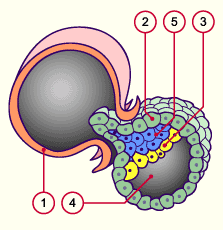
1
2
3
4
5 |
Pellucid zone
Trophoblast (outer cell mass)
Hypoblast (part of the inner cell
mass)
Blastocyst cavity
Epiblast (part of the inner cell mass) |
|
|
|

|
|
Fig. 11, Fig. 12
The embryo emerges from the pellucid zone, leading with the abembryonic pole first.
|

